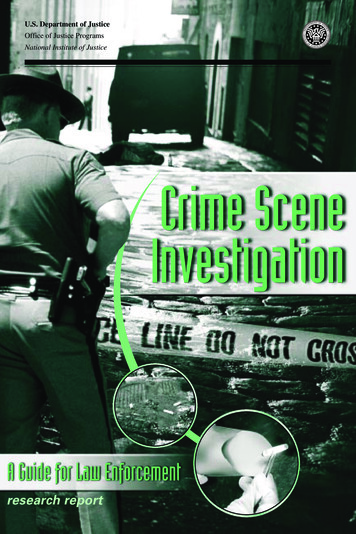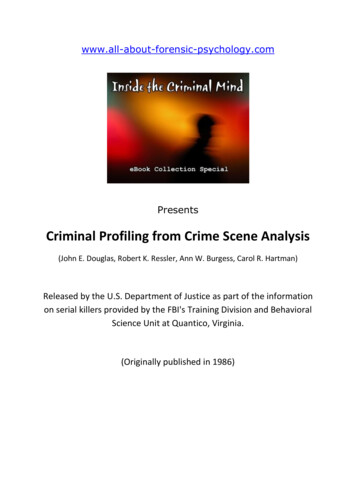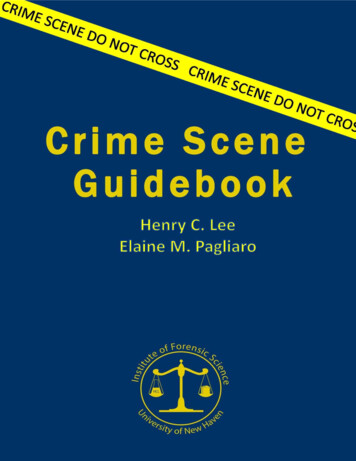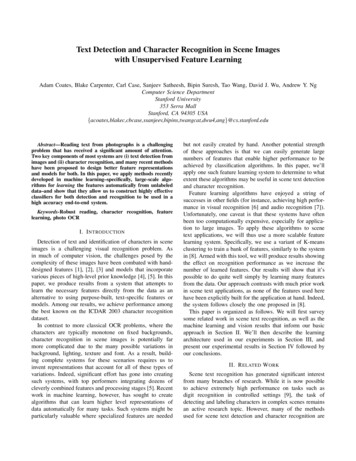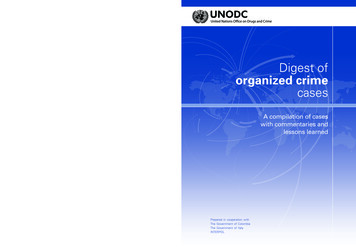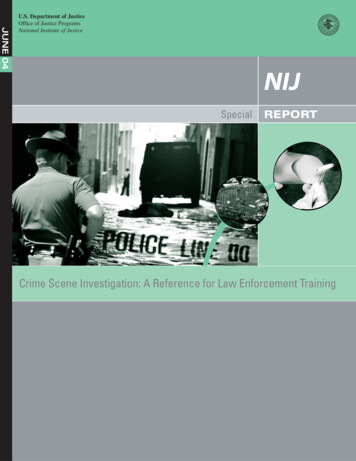
Transcription
JUNE 04U.S. Department of JusticeOffice of Justice ProgramsNational Institute of JusticeSpecialREPORTCrime Scene Investigation: A Reference for Law Enforcement Training
U.S. Department of JusticeOffice of Justice Programs810 Seventh Street N.W.Washington, DC 20531John AshcroftAttorney GeneralDeborah J. DanielsAssistant Attorney GeneralSarah V. HartDirector, National Institute of JusticeThis and other publications and productsof the National Institute of Justice can befound at:National Institute of Justicewww.ojp.usdoj.gov/nijOffice of Justice ProgramsPartnerships for Safer Communitieswww.ojp.usdoj.gov
Crime Scene Investigation:A Reference for Law Enforcement TrainingJune 2004NCJ 200160
Sarah V. HartDirectorNational Institute of JusticeThis document is not intended to create, does not create, and may not be relied upon to create any rights,substantive or procedural, enforceable at law by any party in any matter, civil or criminal.Opinions or points of view expressed in this document represent a consensus of the authors and do notreflect the official position or policies of the U.S. Department of Justice.The National Institute of Justice is a component of the Office of Justice Programs, which also includes theBureau of Justice Assistance, the Bureau of Justice Statistics, the Office of Juvenile Justice and DelinquencyPrevention, and the Office for Victims of Crime.
ContentsIntroduction .1Technical Working Group on Crime Scene Investigation.3Crime Scene Investigation: A Reference for Law Enforcement Training .5Section A: Arriving at the Scene: Initial Response/Prioritization of Efforts .71. Initial Response/Receipt of Information.92. Safety Procedures .113. Emergency Care .124. Secure and Control Persons at the Scene .145. Establish and Preserve Scene Boundaries .156. Transfer Control of the Scene to the Investigator(s) in Charge .177. Document Actions and Observations at the Scene .18Section B: Preliminary Documentation and Evaluation of the Scene .211. Conduct Scene Assessment.232. Conduct Scene “Walk-Through” and Initial Documentation .26Section C: Processing the Scene.271. Determine Team Composition .292. Ensure Contamination Control .313. Document the Scene .334. Prioritize Collection of Evidence .355. Collect, Preserve, Inventory, Package, Transport, and Submit Evidence.37Section D: Completing and Recording the Crime Scene Investigation .451. Establish Crime Scene Debriefing Team .472. Perform Final Survey of the Crime Scene .493. Documentation of the Crime Scene .51Section E: Crime Scene Equipment .531. Initial Responding Officer(s) .552. Crime Scene Investigator/Evidence Technician .553. Evidence Collection Kits (Examples).56Glossary .59Crime Scene Investigation: A Reference for Law Enforcement Trainingiii
IntroductionNote: Words and phrases that are defined in the glossary appear in bold italics on their first appearance in thebody of the report.Thorough crime scene analysis is vitally important to effective law enforcement. In particular, rapid techno logical advances have greatly expanded the amount of information that can be obtained from the analysisof physical evidence from a crime scene. In order to take advantage of these new opportunities, the investigatorshould use sound scene processing practices to recover useful evidence. Critical to the administration of a crimeis the objective recognition, documentation, collection, preservation, and transmittal of physical evidence foranalysis.This reference material is designed to assist trainers and administrators in developing training programs for crimescene investigators. It is intended to accompany Crime Scene Investigation: A Guide for Law Enforcement, pub lished by the National Institute of Justice (NIJ) in January 2000. Both publications were developed by NIJ’sTechnical Working Group on Crime Scene Investigation (TWGCSI). The earlier guide and these training materi als are divided into four primary sections that mirror the tasks of the investigator: Arriving at the Scene: InitialResponse/Prioritization of Efforts; Preliminary Documentation and Evaluation of the Scene; Processing theScene; and Completing and Recording the Crime Scene Investigation. Each part of this document includes pro posed performance objectives for the student to ensure attainment of the material. NIJ recommends that studentperformance be measured using written and practical examinations, including the processing of a mock crimescene.This document can provide the basis for a new training program or as a supplement to an existing program. Anytraining program, however, must be adapted to the policies and experience of the administering law enforcementagency. The crime guide and these curriculum materials provide instructors with a framework grounded inresearch and based on the expertise of the TWGCSI members. The recommendations do not represent the onlycorrect course of action and may not be feasible in all circumstances. In no case should the guide or this refer ence document be considered a legal mandate or policy directive. We expect that each jurisdiction will be able touse these recommendations to develop policies and procedures that are best suited to its unique environment.We gratefully acknowledge the contributions of the TWGCSI members. They gave their time and valuableexpertise for this project. NIJ relies on the contributions of experienced practitioners and researchers to advancescientific research, development, and evaluation to enhance the administration of justice and public safety.Crime Scene Investigation: A Reference for Law Enforcement Training1
Technical Working Group on Crime Scene InvestigationThe Technical Working Group on Crime Scene Investigation (TWGCSI) was a multidisciplinary group ofcontent-area experts from across the United States, from both urban and rural jurisdictions, each represent ing his or her respective agency or practice and a unique area of expertise. Each of these individuals is experi enced in the area of crime scene investigation and evidence collection in the criminal justice system from thestandpoints of law enforcement, prosecution, defense, or forensic science.A planning group, the National Crime Scene Planning Panel (NCSPP), composed of distinguished law enforce ment, legal, and science professionals, was formed to steer the larger group.National Crime Scene Planning PanelDr. Jose R. AlmirallAssociate Director and AssistantProfessorInternational Forensic ResearchInstituteDepartment of ChemistryFlorida International UniversityMiami, FloridaSusan BallouForensic ScientistMontgomery County PoliceDepartmentCrime LaboratoryRockville, MarylandPaul CarrollSergeant (Ret.)Chicago Police DepartmentBig Pine Key, FloridaElizabeth FarrisChief Trial CounselHampden County District Attorney’sOfficeSpringfield, MassachusettsJo Ann GivenASCLD/LABNaval Criminal Investigative ServiceNorfolk, VirginiaMarjorie HarrisForensic Scientist, SeniorDepartment of Criminal JusticeDivision of Forensic ScienceRichmond, VirginiaLarry McCannSenior Special Agent (Ret.)Virginia State PoliceRichmond, VirginiaDr. Joseph L. PetersonDepartment of Criminal JusticeUniversity of IllinoisChicago, IllinoisElliot B. SpectorDirectorCenter for Police and SecurityTrainingSuffield, ConnecticutAnn TalbotASCLD/LABAlbuquerque Police DepartmentAlbuquerque, New MexicoJames T. “Tom” ThurmanAssociate ProfessorCollege of Law EnforcementEastern Kentucky UniversityRichmond, KentuckyAdditional Technical Working Group MembersHal R. ArensteinAttorney at LawLaw Offices of Hal ArensteinCincinnati, OhioDexter J. BartlettInspectorIllinois State PoliceCrime Scene Services CommandJoliet, IllinoisEric BuelDirectorDepartment of Public SafetyCrime LaboratoryWaterbury, VermontJeff CoverSupervisor, Crime Scene UnitAnne Arundel County PoliceDepartmentMillersville, MarylandElizabeth DevineSupervising CriminalistScientific Services BureauLos Angeles County Sheriff’sDepartmentLos Angeles, CaliforniaHenry EscobarDetectiveSan Antonio Police DepartmentSan Antonio, TexasJerry N. EstesDistrict Attorney General10th Judicial DistrictAthens, TennesseeJames EstradaDetective InvestigatorHomicide UnitSan Antonio Police DepartmentSan Antonio, TexasDrew FindlingAttorneyAtlanta, GeorgiaCrime Scene Investigation: A Reference for Law Enforcement Training3
Nan Horvat/John SarconeAssistant Polk County Attorney/PolkCounty AttorneyDes Moines, IowaGalen PaineAssistant Public DefenderPublic Defender’s OfficeSitka, AlaskaClarene ShelleyLieutenantLakewood Police DepartmentLakewood, ColoradoN. Michael HurleyRegional DirectorOregon State PoliceForensic Services DivisionSpringfield, OregonMichael J. RaffertyChief of ForensicsFlorida Department of LawEnforcementFort Myers Regional OperationsCenterFort Myers, FloridaGregory SmithAssistant County ProsecutorOffice of the County ProsecutorCamden CountyCamden, New JerseyGary L. KaldunForensic Scientist, Crime SceneCoordinatorBureau of Criminal ApprehensionSt. Paul, MinnesotaJoe MarchanSupervising CriminalistTexas Department of Public SafetyCrime LaboratoryMcAllen, TexasJoseph John Moseley, IIDetectiveCentral Homicide Evaluation SupportSquadChicago Police DepartmentChicago, IllinoisRobert MullinsDetectiveInvestigative ServicesNew Haven Police DepartmentNew Haven, ConnecticutSteve NashDetectiveMarin County Sheriff’s DepartmentSan Rafael, CaliforniaKathryn Normington-HollenbachSenior Forensic ScientistWyoming State Crime LaboratoryCheyenne, Wyoming4Eugene RifenburgSenior Investigator (Ret.)New York State PoliceInvestigator (current)Oneida Nation PoliceMunnsville, New YorkGary A. RiniPolice Commander (Ret.)DirectorThe American Institute for PoliceScienceElkhorn, NebraskaHeidi RobbinsSupervising CriminalistScientific Services BureauLos Angeles County Sheriff’sDepartmentLos Angeles, CaliforniaDarrell RyanLieutenantNashville Police DepartmentNashville, TennesseeNorman ShapiroVice President, New York StateDefender’s AssociationCounselor at LawLaw Offices of Norman ShapiroMiddletown, New YorkCrime Scene Investigation: A Reference for Law Enforcement TrainingRichard StanekCaptainMinneapolis Police DepartmentMinneapolis, MinnesotaBrad TownsendSergeantCorona Police DepartmentCorona, CaliforniaLarry TurnerDirector of Forensic ServicesJackson Police Department CrimeLaboratoryJackson, MississippiStephen WeichmanCounty and Prosecuting AttorneyTeton CountyJackson, WyomingJames WiserCrime Scene Investigator/Evidence CustodianMount Pleasant Police DepartmentMount Pleasant, South CarolinaLarry WoodDetectiveMajor Case UnitSmyrna Police DepartmentSmyrna, GeorgiaJohn YarbroughSergeantHomicide BureauLos Angeles County Sheriff’sDepartmentCommerce, California
Crime Scene Investigation:A Reference for Law Enforcement Traini
Marin County Sheriff’s Department San Rafael, California Kathryn Normington-Hollenbach Senior Forensic Scientist Wyoming State Crime Laboratory Cheyenne, Wyoming Galen Paine Assistant Public Defender Public Defender’s Office Sitka, Alaska Michael J. Rafferty Chief of Forensics Florida Department of Law Enforcement Fort Myers Regional Operations Center Fort Myers, Florida Eugene Rifenburg .
